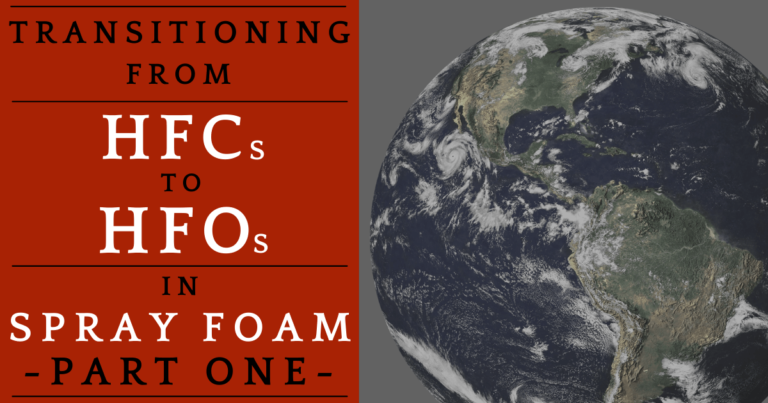What are HFCs and HFOs? Understanding the Transition from HFC to HFO in Spray Foam Blowing Agents, Part Two
Spray foam insulation is an amazing product that helps millions of people all over the world live happier, healthier lives by creating warm, safe environments for them to live in.
At its core, spray foam insulation – or polyurethane foam – is a fantastic product of science.
And since science is constantly evolving, spray foam insulation is constantly changing, too.
The EPA recently released new guidelines regarding hydrofluorocarbon – or HFC – use in spray foam insulation, recommending a transition to hydrofluoroolefin, or HFO, instead.
Why is this transition happening now? Why not earlier?
As time passes, scientists learn more and more about the effects of man-made chemicals on our world. They do this by observing data in real-time.
Thus, scientific conclusions – and any changes they bring – take time…and change is not always welcome.
Large-scale change regarding scientific discoveries – such as transitioning HFC to HFO in spray foam insulation – is accomplished through legislation.
We know that – new or not – rules and regulations can be daunting, especially if they affect one’s livelihood.
However, changes are either coming or already required, and understanding this HFC to HFO transition is vital to navigating the future of the spray foam industry.
Today, therefore, we will unpack what HFCs and HFOs are, why the EPA is suggesting the change from HFC to HFO in spray foam insulation, and which US states already require the transition.
Let’s jump in!
Why Does the HFC to HFO Transition Matter to Spray Foam Insulation?
The transition from hydrofluorocarbons (HFCs) to hydrofluoroolefins (HFOs) is impactful in the spray foam industry because the majority of blowing agents on the market contain HFCs.
A vital part of spray foam chemistry, blowing agents help propel foam onto the substrate when sprayed, assist with foam expansion, and (sometimes) increase the R-Value of the insulation.
To learn more about the chemistry of spray foam, check out the first part of this blog post here!
Essentially, though, when you change an ingredient of a spray foam blend, you’re likely to change the end product as well.
Since HFC-based blowing agents are being replaced with HFO-based ones, a transition period is already underway in the spray foam industry.
This transition period is necessary, and allows spray foam insulation manufacturers the time to make spray foam blends that perform well using HFO-based blowing agents.
Why make the change in the first place?
To understand the need, we must understand the history of HFOs.
What are HFCs and HFOs, and Why Were They Created?
HFOs are known as the “fourth-generation” of refrigerants/propellants.
These chemicals are currently being phased into use in a variety of industrial and household products, including spray foam insulation.
The “first-generation” of refrigerants/propellants were harsh, highly-toxic chemicals like ammonia and sulfur dioxide.
To protect people from exposure to these toxic chemicals in their refrigeration systems and other household products, such as aerosol cans, a “second-generation” of refrigerants/propellants called chlorofluorocarbons – or CFCs – were created.
CFCs proved safer for humans than their first-generation counterparts. However, after many years of research, scientists discovered that CFC use had led to the depletion of the ozone layer in Earth’s upper atmosphere.
And the ozone layer is essential for human health, since ozone helps block harmful UV radiation from reaching Earth’s surface.
In an effort to restore the ozone layer and protect ourselves from health hazards like skin cancer, people created the third-generation of refrigerants/propellants: hydrochlorofluorocarbons, or HCFCs, and hydrofluorocarbons, or HFCs.
Of these two options, HFCs are preferable because they don’t contain chlorine (which wreaks havoc when released in the atmosphere). As such, HFCs display a very low Ozone Depleting Potential (ODP).
However, after years of observation, scientists have discovered that, while HFCs have a low ODP, they have a high Global Warming Potential, or GWP.
Substances with high GWP speed up the process of global warming on our planet, which has direct implications for the safety of humanity.
Therefore, the fourth-generation of refrigerants/propellants was created – Hydrofluoroolefins, or HFOs.
HFOs have both a low ODP AND a low GWP.
Win-win!
HFOs are important for the long-term health of humanity and our amazing planet. However, creating HFOs for spray foam insulation takes time and effort.
The EPA’s SNAP program oversees finding suitable HFO replacements for HFCs in many industrial applications, including spray foam blowing agents.
They have published – and frequently update – lists of HFO-based chemicals that can replace HFC in various products! Check out their list of chemicals for use in spray foam here.
How does the transition from HFC to HFO in spray foam insulation affect you and your business?
That answer depends on your state and the legislation they have enacted.
Which States Have Enacted Legislation Requiring the Transition for HFC to HFO in Spray Foam?
Since EPA guidelines are not laws, they must be accepted and put into effect at the state level of government.
Due to the difficulty of obtaining HFO-based ingredients in today’s market, many spray foam companies have not yet created HFO-based spray foam blends.
However, many states already require – or will soon require – the use of HFO-based spray foam insulation within their borders.
As of June 2022 (when this blog post was published), the list of states that have enacted legislation regarding the transition from HFC to HFO includes the following:
- California
- Colorado
- Delaware
- Maine
- Maryland
- Massachusetts
- New Jersey
- New York
- Rhode Island
- Vermont
- Virginia
- Washington
In addition, Connecticut, Hawaii, Nevada, Oregon, and Texas have legislation in the works.
Here’s a link to a helpful resource on the American Chemistry Council’s website. Using it, you can start researching any changes your state has made to their legislation.
Disclaimer: Make sure you check your state’s specific requirements regarding using HFC and HFO in spray foam. This blog post is intended to be a helpful resource, not legal advice!
If you find yourself in a state requiring HFO-based spray foam insulation and need help sourcing that, give Freedom Foam a call!
We are happy to help you find foam that is compliant with your state’s legislation.
Conclusion
The EPA-suggested transition from HFCs to HFOs in spray foam is currently in progress. Many states have already enacted laws requiring HFO-based spray foam insulation within their borders, and others will continue to do so as time passes.
In response, spray foam companies continue to create new blends that meet EPA guidelines.
Change is all around. And we are all in this together!
If you have questions about the HFC to HFO transition or need help sourcing your spray foam, give us a call!
We look forward to working with you.







